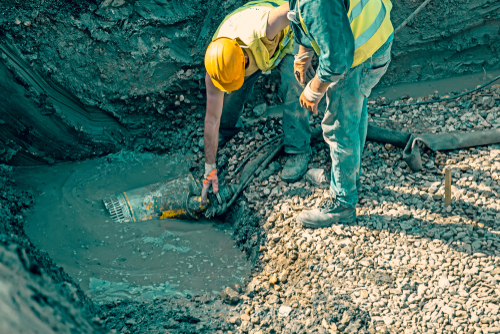Dewatering excavations on a construction site
Preventing water pollution on a construction site while dewatering
 What you must do
What you must do
Abstraction and dewatering
If, as part of your works, you are de-watering or pumping water that has gathered in an excavation, then you will not require an abstraction licence if the water is to be disposed of solely to prevent interference to your building operations.
If you intend to use water from a de-watering operation for dust suppression or pressure testing on site, you may require an abstraction licence.
In Scotland all abstractions are controlled by the 'Water Environment (Controlled Activities) (Scotland) Regulations 2011.
Disposing of water from dewatering operations
In most cases, excavations below ground level will accumulate water.
Before you start work, plan how you will treat and dispose of groundwater that enters your excavations, shafts or tunnels. You should include this information in your method statement.
You may require authorisation to discharge this water into the water environment. Contact your environmental regulator for advice.
If you need an authorisation to discharge to a watercourse, it can take up to four months to obtain.
For long term excavations or large jobs, consider well point dewatering. This method removes the groundwater directly from the ground before it reaches your excavation. As this can have an effect on the local groundwater table, you should contact your environmental regulator when considering this technique.
Contact your environmental regulator
Guidance for Pollution Prevention (GPP) 5 contains guidance on measures you can take to avoid causing pollution during building and engineering work.
GPP 5 Works and maintenance in or near water
General Binding Rules (GBRs) for discharges of run-off water (GBR 10 and 11)
GBR 10 - Discharging water from a surface water drainage system
In Scotland, GBR 10 details the rules relating to discharging water from a surface water drainage system.
GBR 10 has been updated to cover surface water discharge from:
- land used for residential purposes (up to 60 hectares).
- land used for non-residential premises or yards (excluding industrial estates).
- car parks with up to 1,000 spaces.
- metalled roads (excluding motorways and A roads).
- waterbound roads.
and
- constructions sites, where the site, including any constructed access tracks does not:
- exceed 4 hectares.
- contain a road or track longer than 5km.
- include any area more than 1 hectare, or any length of more than 500m on ground with a slope of more than 25°.
If your site exceeds these thresholds then you will require authorisation from SEPA : Water runoff from construction sites
GBR 10 specifies that all reasonable steps must be taken to ensure pollution does not occur.
The discharge must not:
- contain trade effluent/sewage.
- result in discolouration, iridescence, foaming or growth sewage fungus.
- destabilise banks or bed of the receiving surface water.
- contain run-off from fuel delivery areas, vehicle loading/unloading bays where potentially polluting matter is handled or oil and chemical storage, delivery and handling areas. if constructed on or after 1st April 2007.
All parts of the surface water drainage system must be maintained in good working order and repair and steps must be taken to ensure that matter liable to block or obstruct the drainage system is prevented from entering.
Construction specific rules:
Sites must be drained to a Sustainable Urban Drainage System (SuDS) unless the discharge is from a single dwelling or to coastal waters.
All parts of the construction site which began operations on or after 01 June 2018, on which works are to be undertaken or any vehicles are to be operated or parked on, must be drained by a surface water drainage system with the capacity to accommodate the maximum volume of run-off expected to occur from the land during the period of construction.
Good practice
When you operate a water pump, ensure that the pump outlet is positioned away from the excavation to prevent water running back in.
Where possible, switch off the pump before it begins to suck up the last dregs of water as these are likely to contain high levels of silt.
If the base of the excavation needs to be free of water, dig a small sump, put a perforated pipe into it and surround the outside of the pipe with a suitable grade of clean stone. Put the sump pump inside the perforated pipe. This will help stop the sides of the sump falling in and blocking the pump inlet. Although it will keep the base of your excavation free from water, any water produced may still be silty.
If the site is or could be contaminated, or you suspect that the water in your excavation is contaminated with anything other than silt, you must have samples taken and laboratory tested before you pump this water out. The results of these tests will help you decide how to dispose of the water. If the water is not contaminated, you may be able to discharge it over land. However, if it is contaminated you must have it taken off site for disposal. Signs of contamination can include colour, smell or an oily sheen. However, be aware that visual examination or smell alone cannot detect some sorts of contamination.
There is a type of harmless bacteria that can form a multicoloured sheen on the surface of standing water. This sheen looks similar to that caused by oil. The easiest way of distinguishing the two is to drag a stick through the material. If oil is present, then it will usually remain as a constant layer. If the sheen is caused by bacterial growth, then it will break up into smaller pieces with obvious and irregular edges. If in doubt, you should have the water tested before pumping it out. Water that contains oil should be disposed of at a licensed facility as hazardous/special waste.
